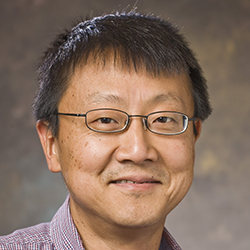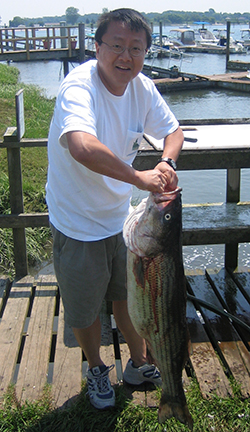Meet Patrick Sung
at Yale University last summer became an associate editor for the Journal of Biological Chemistry. Sung's expertise is in how cells repair double-stranded breaks in DNA. The ═╡┼─═╡┐· and ═╡┼─═╡┐· Biology's chief science correspondent, Rajendrani Mukhopadhyay, interviewed Sung to learn more about his scientific interests, career trajectory from Hong Kong to the U.S., and work and life philosophies. The interview has been edited for length and clarity.
 Patrick Sung
Patrick Sung
What is your research focused on?
We have been focusing on yeast cells and human cells. We want to understand the conserved mechanism of how cells go about eliminating DNA double-strand breaks using homologous recombination as a repair system. (Homologous recombination) is one of the two major DNA repair systems dealing with DNA breaks. The other one is non-homologous DNA end joining.
How did you become interested in studying DNA repair?
I worked for a couple, Satya and Louise Prakash. They are my mentors. (Author's note: Sung was a research associate with the Prakashes at the University of Rochester in the 1980s. The couple is now at the University of Texas Medical Branch in Galveston.)
I worked with them on a completely different DNA repair pathway and actually did very well. The DNA repair pathway that I worked on is called nucleotide excision repair, which doesn't deal with DNA breaks but rather functions to eliminate bulky lesions from chromosomes, such as those induced by ultraviolet light. At that time, I was very happy doing that. But when it came time for me to look for a job and something independent to do, I didn't want to be doing the same thing, because, for one thing, I didn't want to compete with my own mentors. They spent a lot of time talking to me and helping me shape my future. They convinced me that homologous recombination had a great deal of potential. I knew very little about it at that point, but I was convinced this was something in which I could be making some impact in the future.
How were the Prakashes pivotal in your career?
They were so patient. They took me by the hand and not only taught me how to go about proper scientific thinking but also how to put a grant together, how to write a research paper and so on. I remember that we used to write papers during the weekends. We didn't have computers then. We would write every single sentence together. I really give them the most credit. From them, I learned the virtue of being patient. I learned the virtue of not getting too agitated about things.
What were the questions in the field when you started out, and what are the big questions now?
I was trained as a biochemist when I was a Ph.D. student. I did classical enzymology, doing a lot of kinetic analyses and so on. When I entered the field, there were already a handful of really powerful geneticists. Genetics was never my forte, although I understand and appreciate genetics a lot. But I could bring my expertise to understand the (DNA repair) mechanism at the biochemical level.
Our forte has been, in the past 20-some years, to reconstitute very complicated reactions and learn how they work. When I entered the field, there was very little biochemical information available, so by taking one protein at a time, I started to look at the key players of the (homologous recombination) pathway and slowly began to make contributions in elucidating how they work.
Because I was ignorant about homologous recombination when I started, I wasn't constrained by what people thought about how things should work. I started in the field fresh, doing what biochemists always do — the careful titrations of pH and so on. I found things that nobody had found before because of that. Ignorance has served me quite well in that particular regard!
Reconstituting a very complicated reaction entailing 12 or 15 different proteins to try to capture what happens in cells is very hard. So the intellectual question has remained the same over the last 20-something years: How does DNA repair work? The complexity is quite astounding. We are doing single-molecule work in collaboration with others. We are also doing structural biology in collaboration. We still do a lot of genetics by ourselves and also in collaboration with others. But we have made pretty significant contributions, I would say, in understanding the biochemical mechanism of homologous recombination to repair DNA.
What sparked your interest in science?
My parents always wanted me to go to medical school. I have a brother who always was at the top of his class. He ended up going to medical school. I always was a B student, even a C student at times, depending on how much I studied. I never liked studying. I just couldn't focus on flipping through a textbook. I hated it.
But I knew that I needed a career. I thought I would go to graduate school. I found that I liked it because it required constant thinking. Every day, I did something different rather than same-old, same-old. That really interested me and convinced me that research was something that I could do reasonably well. My initial goal was rather modest — to find a career to pay my bills.
As I got more and more involved in research, I realized I could do it actually rather well! At that point, I made up my mind that I wanted to be a faculty member. This was around the time when I was getting done with my Ph.D. at the University of Oxford.
How did you get to the U.K.?
I was born and raised in Hong Kong. I finished high school and was mulling over where to go for college. I wasn't good enough to get into the local university. Yes, seriously. Not even close. I was more focused on partying than studying. But I did focus on getting good grades in my advanced level exams, and I did reasonably well. (Author's note: Advanced level exams are pre-university courses in the British education system.)
I was admitted into different universities in the U.K. I picked the University of Liverpool because the soccer team was the best at the time. I love soccer. So I went to Liverpool for my undergraduate work because of the soccer team.
 Fishing is one of Patrick Sung's favorite pastimes. Photos courtesy of Patrick Sung
Fishing is one of Patrick Sung's favorite pastimes. Photos courtesy of Patrick Sung
You've been a JBC associate editor for a year. What does it mean to you to be an associate editor for the journal?
I believe I am playing a very important role in shaping nucleic acid biochemistry, at least within my realm, in selecting the best work to publish. I think I'm playing a very important role, particularly in helping younger people to get their best work published.
What are your hobbies?
I don't play soccer anymore because of time and age. I enjoy going to soccer tournaments with my 16-year-old son. He's a pretty good soccer player, and I really enjoy going to soccer games with him. I love fishing, but I haven't done any fishing in three or four years, because time is an issue.
Any advice for young scientists?
Just be patient. Develop a superior work ethic. That is absolutely essential. There are so many things going on outside of the lab, so many different distractions. In order to be successful, one has to be completely focused. Every single project one undertakes now is so much more complicated. It used to be you could write a paper on the biochemistry or genetics of a research question. These days, you have to combine biochemistry with some cell biology or genetics. Unless one focuses, it's really hard to compete.
What's your motto in life?
Stay optimistic! Tomorrow will be a better day. When I'm all down and out, I tell myself that tomorrow mostly likely will be a better day. Most of the time, it turns out that things have a way of resolving themselves.
Enjoy reading ASBMB Today?
Become a member to receive the print edition four times a year and the digital edition weekly.
Learn moreGet the latest from ASBMB Today
Enter your email address, and weтАЩll send you a weekly email with recent articles, interviews and more.
Latest in People
People highlights or most popular articles

Guiding grocery carts to shape healthy habits
Robert тАЬNateтАЭ Helsley will receive the Walter A. Shaw Young Investigator in Lipid Research Award at the 2025 ASBMB Annual Meeting, April 12тАУ15 in Chicago.

Leading the charge for gender equity
Nicole Woitowich will receive the ASBMB Emerging Leadership Award at the 2025 ASBMB Annual meeting, April 12тАУ15 in Chicago.

Honors for de la Fuente, Mittag and De La Cruz
César de la Fuente receives the American Society of MicrobiologyтАЩs Award for Early Career Basic Research. Tanja Mittag and Enrique M. De La Cruz are named fellows by the Biophysical Society.

In memoriam: Horst Schulz
He was a professor emeritus at City College of New York and at the CUNY Graduate Center in Manhattan whose work concentrated on increasing our understanding of mitochondrial fatty acid metabolism and an ASBMB member since 1971.

Computational and biophysical approaches to disordered proteins
Rohit Pappu will receive the 2025 DeLano Award for Computational Biosciences at the ASBMB Annual Meeting, April 12-15 in Chicago.

Join the pioneers of ferroptosis at cell death conference
Meet Brent Stockwell, Xuejun Jiang and Jin Ye тАФ the co-chairs of the ASBMBтАЩs 2025 meeting on metabolic cross talk and biochemical homeostasis research.

